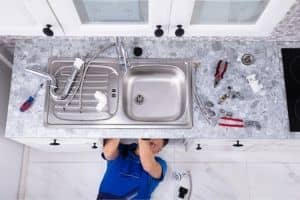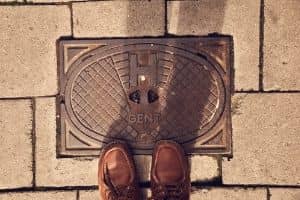
A little education never hurts, which is why we’re here to school you on all you need to know about your plumbing system with this primer on Plumbing 101.
In this article, you’ll find everything from general info to the specifics of those peskier areas like the kitchen sink. Keep reading to find out all you need to know to keep your home’s plumbing system running smoothly so you can focus on more important things.
Plumbing Basics: Moving Through the Pipe System

The basic setup of your plumbing system is a subject you can ace in a heartbeat. Once you understand that the plumbing system is just a series of pipes, tanks, and faucets, it becomes a little less intimidating.
Although the specifics of each plumbing system vary from home to home, the general setup is the same. With the long showers comes the dreaded large water bill. This is because the water in your home comes from a general municipal supply in your street.
The water moves into your home through a series of tanks, faucets, and pipes. Many of our most important resources travel through pipes. The system within a single home can be quite complex, and the specifics can vary between houses. However, the general setup is basically the same.
There is a main water line that transports water from the municipal supply in the street into your home. This line carries cold water through a water meter that gauges exactly how much water is passing through.
The cold water you use comes straight from the main line, while hot water is transported to the water heater. Pipes can be made of various materials, but the most common ones are plastic, copper, and other galvanized metals.
The Kitchen Plumbing System
 Your kitchen plumbing system can be the source of much anxiety. Many of the issues that can arise have to do with a clogged sink. Many homes’ kitchen sinks operate similarly in terms of plumbing.
Your kitchen plumbing system can be the source of much anxiety. Many of the issues that can arise have to do with a clogged sink. Many homes’ kitchen sinks operate similarly in terms of plumbing.
Also, the more appliances there are, the more of a chance there is for other plumbing issues. But don’t fear. This is your crash course into the world of what’s below your kitchen.
Many homes have kitchen sinks that hook up to a hot and cold water line as well as a drainage line. Faucets that are attached to the spigot stop and start the flow of water when turned. There are often other attachments in the wall for cold water to flow from the main supply to the other appliances in the kitchen.
The refrigerator may connect to a water line in order to provide water to the ice maker. There are often dishwasher hookups which connect to the main line and often just connect right to the sink. Be sure to check these lines regularly, as leakage can do damage to the pipes and the furniture around them.
The kitchen plumbing will also connect to a drainage system. This section is well known to those who have common sink clogs. The next section will explain this extremely important yet sometimes unpleasant plumbing component.
The Importance of the Drain System

This system is extremely important for your home. It is the waste disposal system that uses gravity to remove unwanted substances. The drainage system consists of drains, pipes, and vents to do its job.
As waste is distributed through the drain to the trusty pipe system, it is aimed downward to the sewage system below the home. Gravity pushes the waste down the drainage pipes until it exits the home.
Fortunately, another key component is working to alleviate any residual odor from the waste as it travels through the home. A vent at the top of the pipe pushes odors out the other end as it travels toward the sewer.
Now that you’ve completed Plumbing 101, you will be able to navigate simple plumbing issues that may arise. If you still have questions or a problem that may require professional help, like drain cleaning services, make sure to call us for a plumbing inspection or any other HVAC needs.

